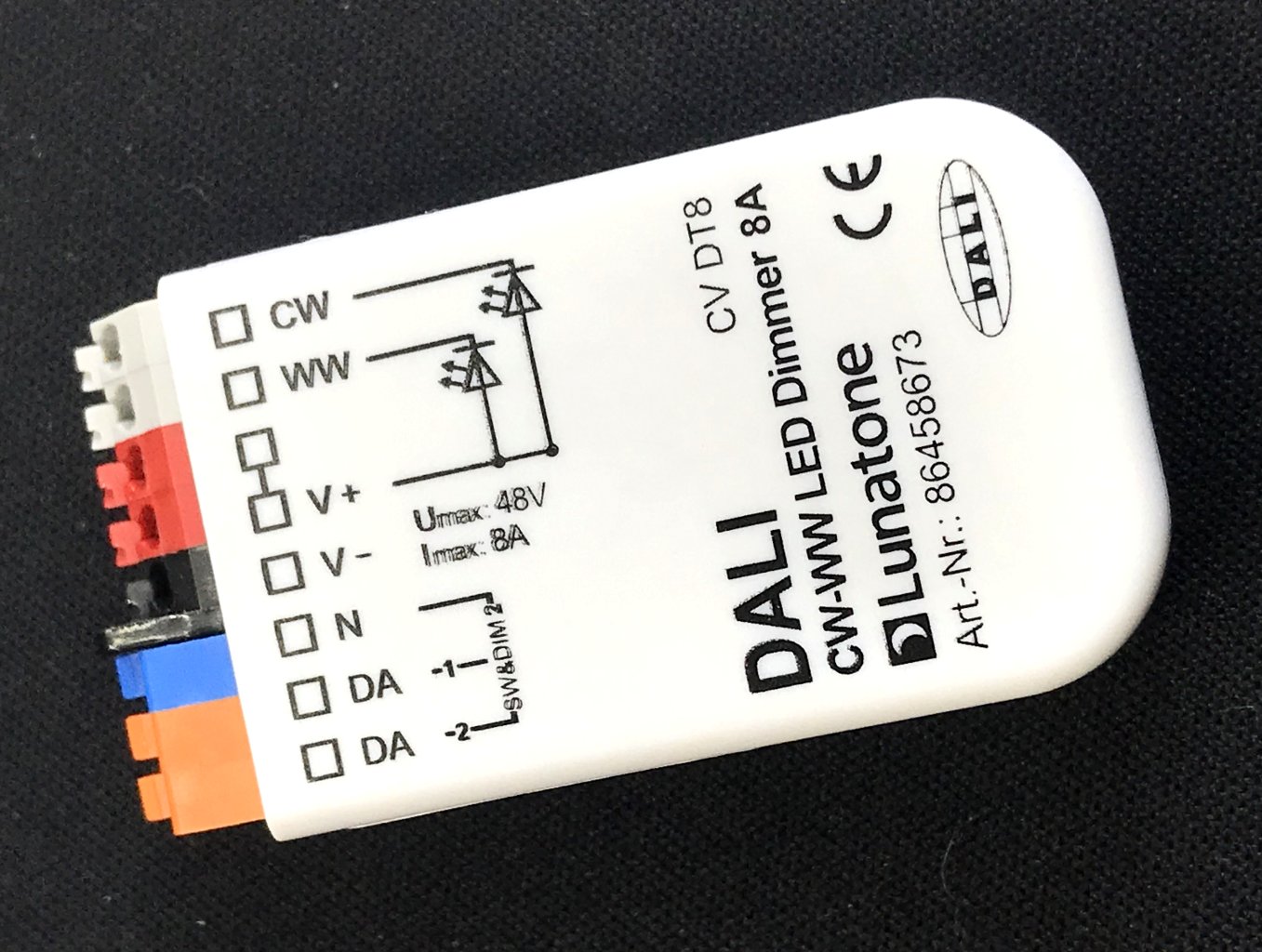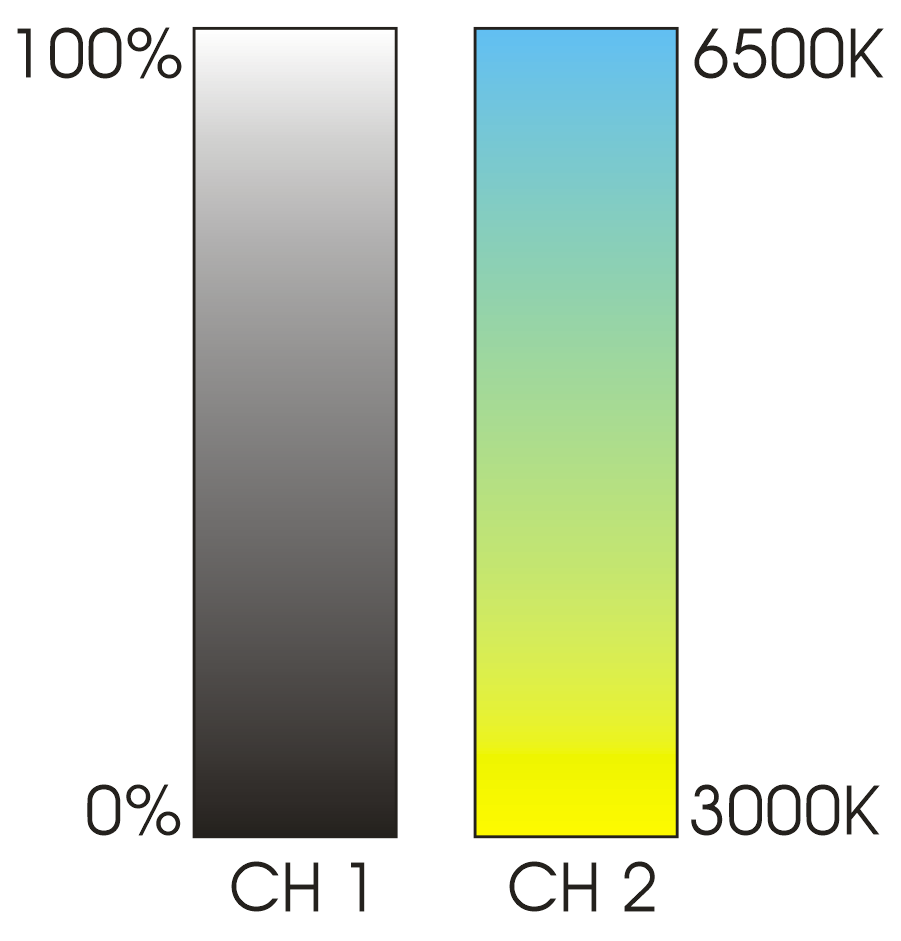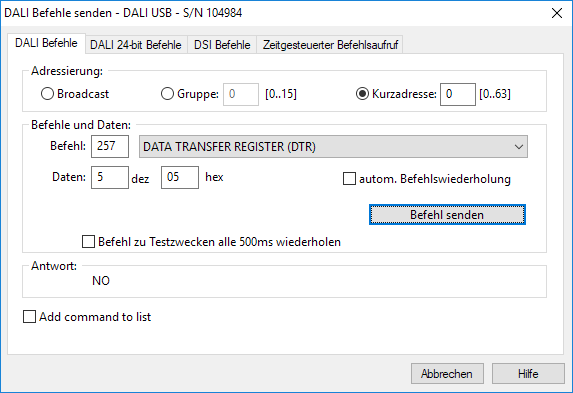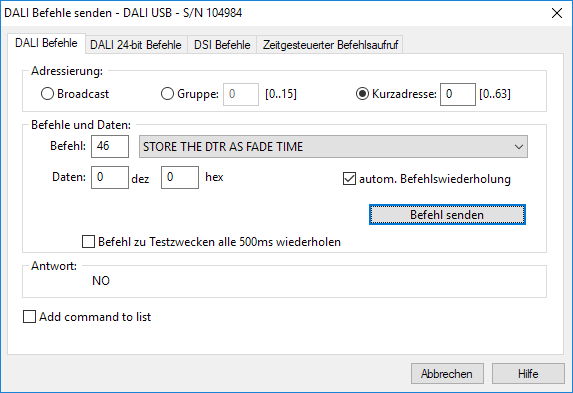TECHNISCHE TIPPS - FAQ |
|
TECHNICAL HINTS - FAQ |
Das Gerät ist auf 1 Adresse eingestellt. Wie bekomme ich mehr?
- Durch die werksseitige Einstellung ist sichergestellt, dass alle Geräte bei Auslieferung gleich reagieren und daß
alle Befehle so schnell wie möglich abgearbeitet werden. Laden Sie das
Gerätemanual, das eine Anleitung enthält, wie man
die Anzahl der unterstützten Adressen leicht ändern kann.
|
|
The decoder has been preset to 1 address. How to get more?
- The factory defaults setting ensure that all devices behave the same when leaving the factory, and that all decoders are
sending data onto the DALI data bus, that can be processed as fast as possible. Pls refer to the product manual,
which contains instructions how to change the number of supported addresses.
|
| |
Kann man DALI Geräte direkt anschließen?
- Alle Teilnehmer können direkt angeschlossen werden. Als Verdrahtungsschemata für den DALI Bus sind Linie, Stern,
Baum oder Bus-Topologie geeignet. Bitte beachten Sie, dass der DALI Bus von einer DALI Bus PSU gespeist werden muss,
um funktionieren zu können.
|
|
Can DALI devices be connected directly to the decoder?
- All DALI participants can be connected directly, using a in-line, a star, a tree or a bus topology. Ring topologies must not be used.
Please note, that the DALI bus must be powered using a DALI Bus PSU. Otherwise, it will not work.
|
| |
Warum ist 1 Kanal bzw. Broadcast voreingestellt?
- Der DALI Bus ist der begrenzende Faktor. Seine limitierte Übertragungsgeschwindigkeit ist der Engpass (DALI:
2400 Bit/s, DMX: 250000 Bit/s). Hinzu kommt, daß bei DMX jeweils nur ein Intensitätswert übertragen werden muß, bei DALI
aber sowohl eine Adresse als auch ein Intensitätswert - und das beides auch noch doppelt codiert. So ist DALI noch
einmal 1/4 langsamer (im Vergleich zu DMX512: 250.000 bit/s hat DALI daher nur effektiv 600 bit/s). Damit ist DALI
effektiv über 400x langsamer als DMX. Ein Datenpaket dauert
25ms, 4 Datenpakete 100ms. In der gleichen Zeit sind mindestens 3 komplette
DMX Telegramme durch - das sind insgesamt 1536 Kanäle! Am Decoder liegt's also nicht... Bitte beachten Sie also, dass
bei Verwendung von mehr als 4 Adressen simultan deutliche Verzögerungen auf dem Bus auftreten können, das sog. "DALI DELAY"

Für DT8 Kommandos wird das Timing zudem noch viel kritischer, denn DT8 Kommandos sind zumeist aus mehreren Standardkommandos
zusammengesetzt. So müssen allein zur Änderung der Farbtemperatur einer Leuchte insgesamt 6 Einzelbefehle abgesetzt werden. Die
dazu notwendige Zeit beträgt 6*25 = 150ms. Das entspricht einer Refreshrate von 6 Hz (für nur eine Leuchte!). Zum Vergleich: Die
DMX Refreshrate beträgt 44 Hz - aber nicht für eine, sondern für 512 Adressen! Wir empfehlen daher, die interne Fadezeit der angeschlossenen DALI Teilnehmer
auf 2...2,8 Sekunden einzuprogrammieren, damit eine Farbtemperaturänderung nicht stufig wird. Wenn Sie schnelle
Warmweiss-Kaltweiss-Steuerung benötigen, warum vermeiden Sie nicht DALI und verwenden gleich einen DMX Decoder, der direkten
Ausgang für 2 Farbstrips bietet: der 3644PWM-H arbeitet immer in Echtzeit! |
|
Why is the device preset to only 1 channel or broadcast mode, respectively?
- The limiting factor is the DALI bus itself. Its speed is limited to 2.400 bps, as compared to DMX (250.000 bps). What's more,
while DMX only has to transmit a single intensity byte, DALI has to transmit channel number plus intensity value, and both
data must be encoded twice. Thus the resulting speed is just one quarter (which is net 600 bps as compared to DMX512: 250.000 bps).
Thus DALI is effectively more than 400 times slower than DMX512. One DALI data packet needs 25ms, four packets
can be transmitted in 100ms. In the same time, more than 3 complete DMX telegrams have been received - containing 1536 DMX data slots.
Thus it's not the decoder slowing down the performance... Please keep in mind, that addressing more than four DALI
devices simultaneously may result in noticeable bus delays, which may cause signal stepping.

When using DT8 commands, timing will be even more critical. Since most DT8 commands are composed of several individual commands,
communication speed is slowes down dramatically. The command to change color temperature is composed of 6 standard commands,
which will take 6x 25ms = 150ms to complete. This is a refresh rate of about 6 Hz (for only one address). Compare this to the standard
DMX512 refresh rate of 44 Hz - not just for one, but for 512 addresses! Thus we strongly advise to program the internal fade time of connected devices
to 2...2,8 seconds to smooth the resulting DALI stepping... When real-time compatible warmwhite/coldwhite colour changes are
needed, why not consider bypassing slow-speed DALI stuff and use high-speed DMX equipment? Our 3644PWM-H
drives 2x 2 outputs and guzarantees immediate response!
|
| |
Mit welchen Geräten kann ich über DMX eine Farbtemperaturänderung realisieren?
- Wenn Sie mit einem DALI System arbeiten müssen, dann wäre der Decoder 7048B-H als Umsetzer auf DALI DT8 einzusetzen.
Als DALI Treibermodul eignet sich ein CV DT8 Driver (siehe Abbildung), und als LED-Streifen ein kombinierter CW/WW-Strip.
Als reine DMX-Lösung hat natürlich ein WW/CW-Decoder 3644PWM-H, der einen WW/CW-LED-Streifen direkt bedienen kann,
die deutlich bessere Performance. Neben einer wesentlich höheren Auflösung als bei DALI haben Sie dann auch zugleich eine
reaktionsschnelle, echtzeitfähige Lösung zur Verfügung.
 |
|

Eine optimale Warmweiss-Kaltweiss-Farbmischung erhält man mit dicht nebeneinander angeordneten LEDs. Für die optimale
Farbtemperatur-Überblendung gibt es spezielle Strips. |
|
|
|
Which devices allow to control color temperature from DMX512?
- When working with a DALI system, using a 7048B-H as converter from DMX to DALI DT8 is the best choice. Use
DT8 compatible LED driver modules (see pictured below) and a combined WW/CW LED strip.
Of course a true DMX solution using a 3644PWM-H LED driver as warm white / cold white controller would be a much superior solution.
The DMX controller features real-time response and higher resolution as compared to DALI drivers.
 |
|

The best warmwhite / coldwhite colour mixing can be achieved using bilocor SMD (surface mounted devices) LEDs. Special
LED strips allow seemless CT changes. |
|
|
| |
Wie steuert man die Farbtemperatur?
- Für jede DALI Adresse werden auf der DMX Ansteuerung zwei Fader bereitgestellt. Dabei dient jeweils
ein DMX Kanal zur Einstellung der Helligkeit, der zweite zur Einstellung der Farbtemperatur. Man kann maximal bis zu 16 DALI
Adressen bedienen - dazu werden dann 32 DMX Slots benötigt.
 |
|
How do I change the colour temperature?
- Each DALI address requires two DMX slots - one for intensity control, the second for colour temperature control.
Since up to 16 DALI addresses (single addresses or group addresses) can be supported, up to 32 DMX slots will be needed
to control connected fixtures.
 |
| |
Wie stellt man die FadeTime ein?
- Die DALI Fade Time wird durch einen Parameter im Bereich 0...15 repräsentiert, wobei der Wert 0 die Fadezeit Null (kein Fade) repräsentiert.
Um einen Wert einzugeben, muss dieser zunächst in das Befehlsregister geschrieben und dann in das Fade-Time-Register übertragen werden.
Es sind also zwei Kommandos nötig. Das Beispiel zeigt, wie man die Fadetime auf den Wert 5 (entsprechend 2,8s Fade) setzt.


Wählen Sie Befehl 257, um den Wert 5 in das Kommandoregister zu laden. Kopieren Sie dann das Befehlsregister in das Fadezeit-Register.
|
|
How to change the DALI Fade Time?
- The DALI fade time is defined as parameter in the range 0...15, where 0 represents the fastest time (no fade). To change
the fade time, the value must be written to the command register and then transferred to the fade time register. Thus
two commands must be executed. The example shows how to set the fade time to "5" (DALI setting for 2.8s fade time).


Use command 257 to load the command register with value 05. Use command 46 to copy the command register to the fade time register. |
| |
Können mehrere DALI Decoder parallel an den DALI Bus angeschlossen werden?
- Theoretisch ist das möglich, mehrere Controller an einem DALI Bus zu betreiben. Voraussetzung ist, daß sie erkennen, wann ein
anderer Controller den Bus belegt und dann "still" sind - der 7048B-H erkennt andere Bus-Aktivität.
Controller, die kein aktives Bus-Monitoring haben, würden gegebenenfalls senden, wenn bereits andere Kommunikation stattfindet
und dann die Befehle zerstören. Wegen der hohen Datenmenge auf dem DALI Bus, die bei der Umsetzung DMX auf DALI anfällt,
ist aber für den Spielbetrieb davon unbedingt abzuraten. Für den Notbetrieb können zusätzliche Taster-Interfaces
angeschaltet werden.
|
|
Is it possible to connect multiple DALI decoders to the DALI Bus?
- Theoretically, more than one controller can be connected to the DALI bus, but it must be ensured, that only one controller
sends data onto the bus at a time. Thus controllers must be able to detect bus activity and refrain from accessing the
DALI bus. The 7048B-H can do so, but since the DMX to DALI conversion generates much traffic on the DALI bus
we strongly suggest to use the DMX to DALI controller as single controller anyhow. Only when used as emergency
control or operated only when DMX control is not active, additional DALI keyboard interfaces may be added to the DALI bus.
|
| |
Gibt es eine Möglichkeit, mehrere DALI Geräte einzeln, aber synchron über DMX anzusteuern?
- Ja, aber das bedingt eine andere DALI-seitige Verkabelung. Hier benutzt mann dann einen Decoder, der mehrere
DALI Ausgänge bereit stellt, sodass jedes DALI Gerät von seinem eigenen Port angesprochen werden kann. Wir nennen das
"DALI DIREKT". So werden alle Teilnehmer gleichzeitig mit Daten versorgt, und ein Update ist in mindestens 25ms
erledigt. Das ist auch DMX-Telegramm-Echtzeit! Sie benötigen mehr DMX/DALI Decoder, sparen dafür aber auch die sonst für
den Bus notwendigen DALI PSU. Und: Sie sparen die DALI Adressierung! Das part zeit und extra Kosten.
Die benötigten Decoder finden Sie hier
|
|
Is there any possibility to drive more DALI ballasts individually but synchronously in real time?
- Yes, it is possible, but this requires a completely different wiring scheme on the DALI side. The DALI bus scheme cannot be used.
The decoder to be used has multiple DALI ports, each driving its own ballast. Thus all DALI devices can be addressed
simultaneously in parallel, and a full update can be achieved in 25 ms - which is well within the DMX specifications. You may
need more DMX-DALI decoders then, but on the other hand you save the expensive DALI bus power supplies. And: you do not need any DALI
addressing at all, saving time and extra installation expenses. Find suitable decoders here
|
![[SOUNDLIGHT LOGO]](../../soundll3.gif) DMX -> DALI BUS CONVERTER DT8 DMX IN - DALI DT8 WW/KW OUT
DMX -> DALI BUS CONVERTER DT8 DMX IN - DALI DT8 WW/KW OUT
![[SOUNDLIGHT LOGO]](../../soundll3.gif) DMX -> DALI BUS CONVERTER DT8 DMX IN - DALI DT8 WW/KW OUT
DMX -> DALI BUS CONVERTER DT8 DMX IN - DALI DT8 WW/KW OUT
![[DMX INTERFACE]](7048b-h.png)